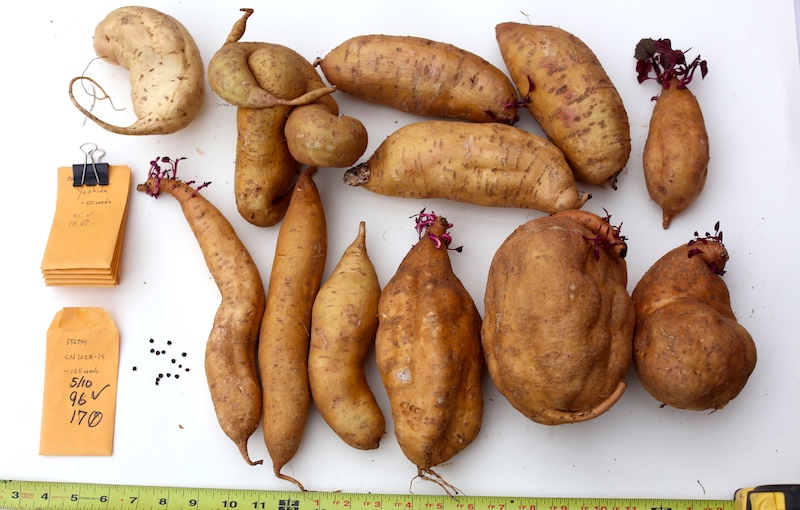
Farm Bulletin: Propagating a Tropical Fruit in a Less-Than-Tropical Climate
Contributor Anthony Boutard of Ayers Creek Farm in Gaston, Oregon, is always up for a challenge when it comes to adapting his favorite foodstuffs to our maritime climate.
Sweet potatoes are propagated as clones; shoots are cut from the tuber and rooted. Those slips are genetically identical to the tuber, absent a mutation, and assure the next crop will have a similar look, flavor and texture. The curse of uniformity is that life, at least for some of us, becomes very dull indeed when everything looks and tastes the same.
For diversity, the farmer must rely on sexual reproduction which leads to a reordering of the crop’s genome. As a tropical crop, the floral biology of the sweet potato is poorly adapted to our latitude and climate, actually completely worthless, at least in terms of reproduction. Sometimes they will flower, a lovely flower at that, but seed set is beyond their capabilities. Consequently, breeders must work their magic in subtropical and tropical locations.

In 2016, knowing our interest and experience in growing sweet potatoes in Oregon, Jay Bost of GoFarm Hawaii and John Hart of EarthWork Seeds approached us to see if we would plant some of their seeds they harvested from their breeding work on Hawaii. We were game, so they sent us some packages. The seeds are tiny and the instructions advised that the hard seed coat had to be nicked, then the seed soaked to assess viability. If the seed started to germinate we could plant it. Following this difficult protocol, Carol managed to start 250 plants and these were planted in the field.
That autumn, we pulled the plants and identified just five out of the 250 that had potential in this climate, and we weren’t especially fussy. Most failed to produce any tubers, those that did have swollen roots produced mere rat-tails as they are termed, about as plump as a pencil. A similar phenomenon occurs with tropical races of corn, the stalks grow and grow and grow and grow and grow, as though reaching for the moon, with nary an ear maturing by the time our frost falls. The difference with this breeding effort is that the breeders specifically selected parents with potential to produce tubers at this latitude. Even so, nature maintains the house odds. Bost and Hart were gambling against the tropical nature of the crop and only beat the house two percent of the time. On par with Las Vegas casinos or the state lotteries; actually not so bad when you think of it with that perspective.

Of the five successful plants from the 2016 planting, all were white-fleshed and tawny-skinned. Although we continued to propagate the other sweet potato varieties in our stable, by this year it was apparent that only one of the old guard remained, the obnoxiously named "White Delight" (top photo, upper left), and only a handful of tubers at that. The Bost and Hart sorts had swamped our genetic stable with their vigor and contentment in our climate. As far as I can tell, three sorts dominate. On the left, there is the long, smooth-skinned tuber with few lateral root scars. The second, at the top, is plumper with many more scars and a furrowed shape. The third is very large, distinctly furrowed, rotund, with a scurfy skin. Aside from appearance, they all have good flavor and pleasant sugar levels.
We will add that this year was a stellar sweet potato moment—an unstintingly hot and long growing season. Enjoy them. Oh yes, as someone who frets at stupid variety names, these tubers are, as yet, unnamed. Oh glorious anonimity! If you must name them, "The Bost & Hart Seedling Grex" is the correct way to refer to these tubers. "No Name Yet" also works just fine, and is just as smart.
Last year, the New York Times had an article about the quest for quality sweet potatoes, or yams as is your wont. The lesson being, forget those in the grocery store. That is precisely why we grow our own.
Top photo by Anthony Boutard. Photo of Jay Bost from the GoFarm Hawaii website. Photo of John Hart by Shawn Linehan.